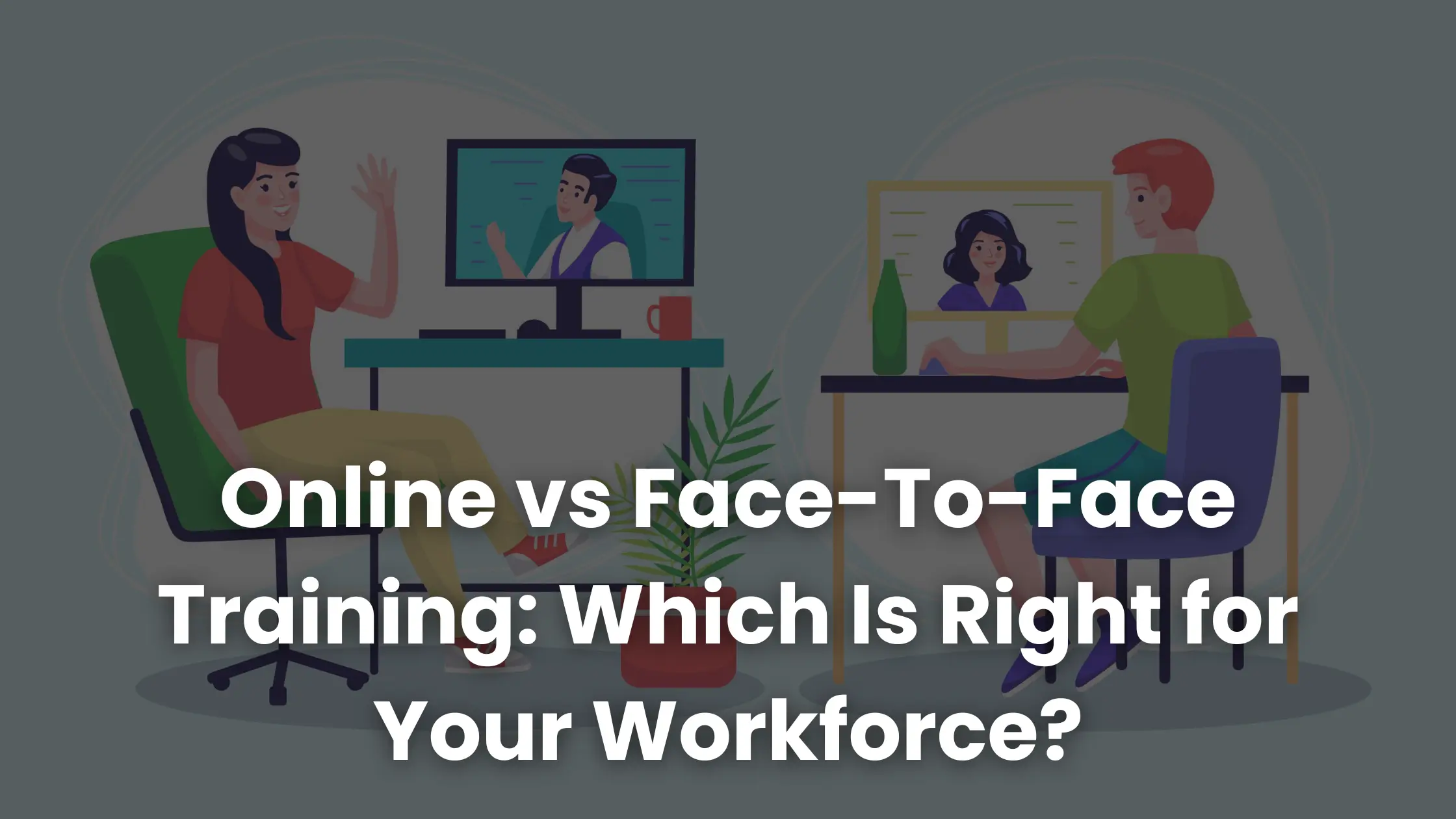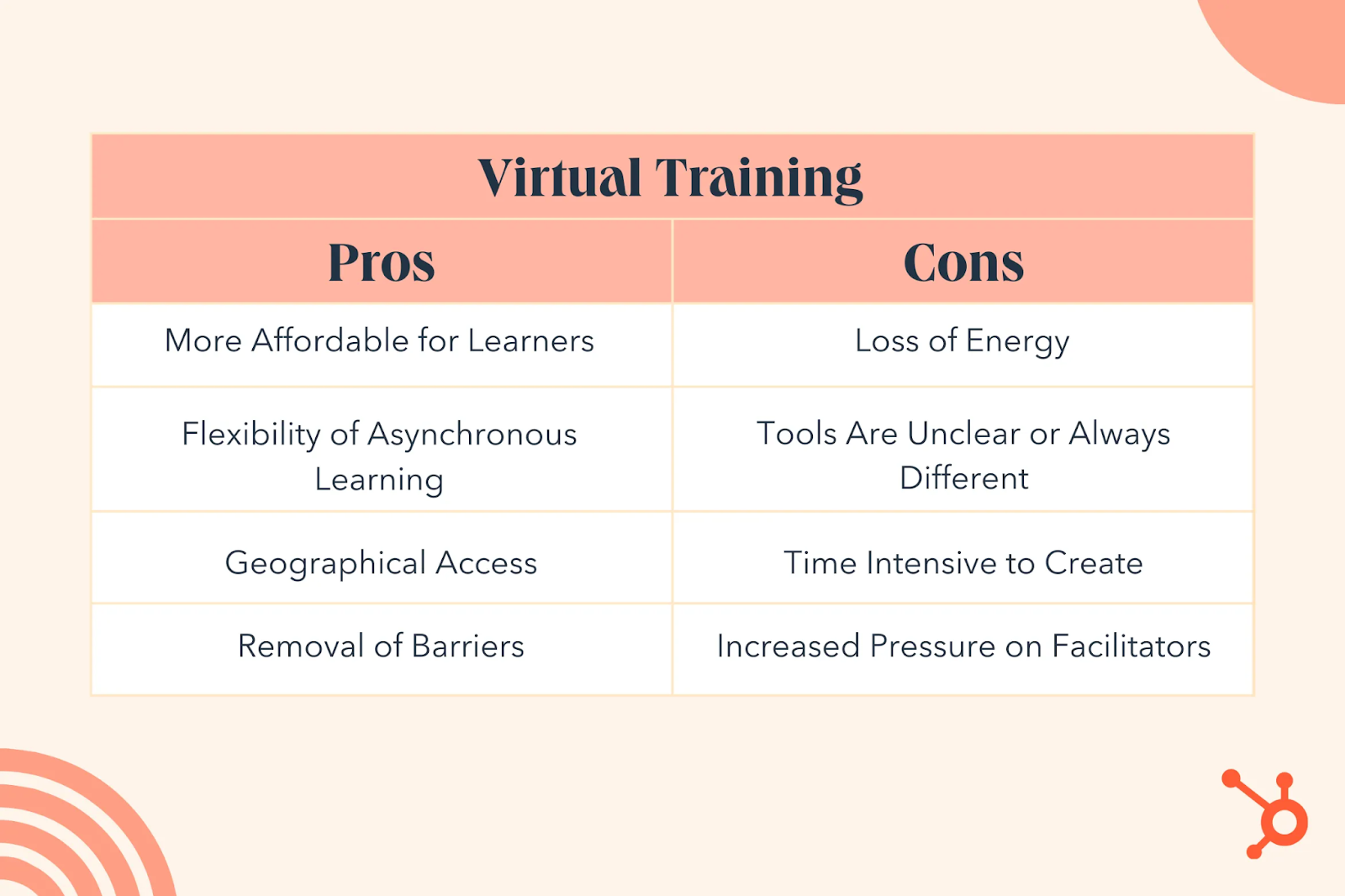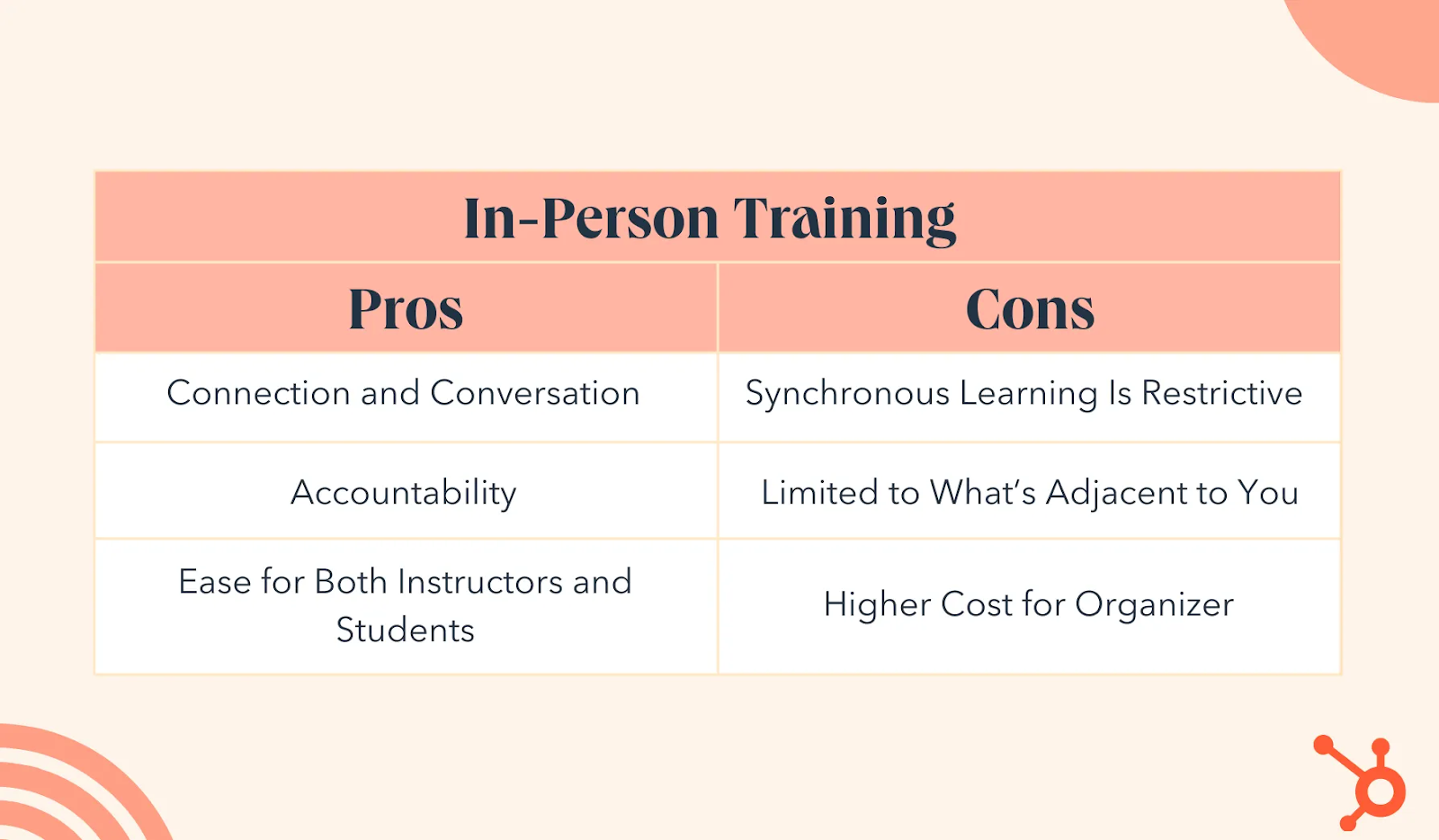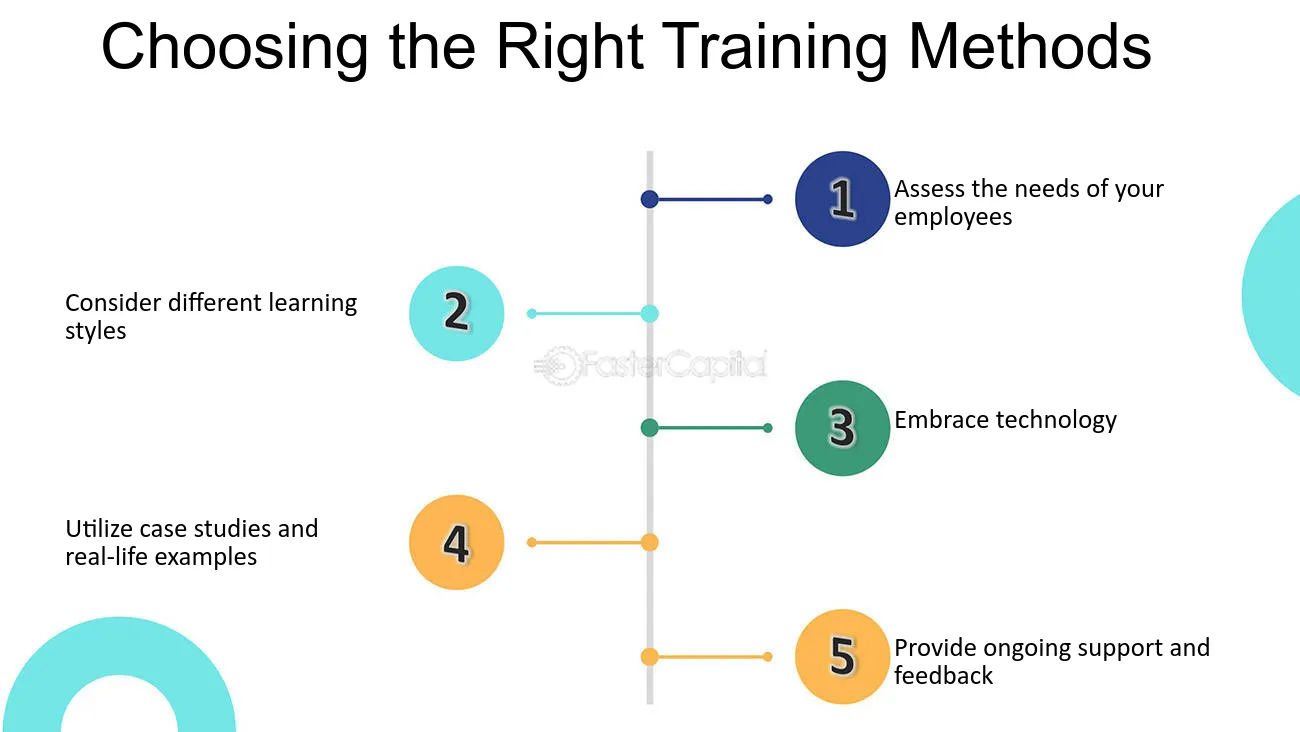Online vs Face-To-Face Training: Which Is Right for Your Workforce?
Online training is gaining traction for workforce learning, but is it worth replacing face-to-face? Explore online vs face-to-face training to decide.
Online training is gaining traction for workforce learning, but is it worth replacing face-to-face? Explore online vs face-to-face training to decide.

Today, many organizations have embraced the hybrid workplace setup. Some of their employees work from home in different time zones, while others work in-person from the physical offices.
While that’s an efficient approach, it also presents a constant dilemma for decision makers. “Should we adopt a fully online training system, or keep it face-to-face?” The truth is, online and face-to-face training both have their pros and cons.
According to a Brandon Hall Group study, eLearning programs take 40 to 60% less time to complete than traditional courses. This means online learning programs significantly reduce the learning durations while boosting engagement. On the other hand, traditional learning offers fewer distractions than online learning and fosters more human collaboration.
In this article, we dig into online vs face-to-face training, showing where each works best to help you make an informed choice.
Online training refers to the training delivered through digital platforms. It is either synchronous (live virtual sessions) or asynchronous (self-paced modules).
Microsoft’s global upskilling initiative is a strong example of online training. It successfully trained 25 million people worldwide in under a year.
Elearning keeps the workday intact. There’s no rushing across town and no need to reshuffle a whole day. Employees just log in, learn what they need, and carry on. It means parents juggling school pick-ups, teammates with mobility challenges, or anyone who needs translation or accessibility tools built right in can join.
Combine accessibility and inclusivity with a program that has clear modules, smart sequencing, and interactive challenges, and you’ll watch knowledge stick. Pair it with spaced repetition and you’re not just teaching; you’re hardwiring skills.
In fact, retention rates can climb by 50% or more when training feels alive instead of static.

Online training is effective for reaching people quickly, but it also has certain downsides. Here are the common problems of online training:
You can overcome these challenges.
Remember, design and delivery matter just as much as the training material. If your team struggles with slow connections or scattered devices, the fix is to centralize everything in one hub. LMS platforms like Coursebox handle this well.
With Coursebox, learners can access materials without delay, even with low bandwidth. If focus drops because people juggle work and training, you can use built-in interactive checkpoints, such as quizzes, polls, and branching scenarios, to pull them back in.

Losing the group dynamic? Create shared challenges or leaderboards inside Coursebox so everyone sees each other’s progress. If managers can’t tell who’s on track, Coursebox’s real-time dashboards flag bottlenecks instantly, letting you nudge the right people at the right time.
Face-to-face training takes place in a room, where a person guides the group. Everyone’s in the same space, tuned into the same moment. Whenever someone asks a question, the other person answers it immediately.
Face-to-face training also involves fewer interruptions and quicker feedback. For hands-on work, such as machinery, lab work, and safety drills, this speed of correction is invaluable.
With this training approach, the trainer can easily identify errors in the learning materials or resources and fix them before they confuse other learners. This keeps the entire group moving forward together.
That’s also the reason why in-person workshops are great for high-stakes areas like technical mastery. There’s no lag between error and improvement, which enables every learner or employee to focus only on sharpening their skills.

Here are the common problems of face-to-face training:
How do you overcome these? Try cutting down classroom time by sending out pre-learning materials online. You can also record sessions, so those who were not able to attend can still benefit from the training. Moreover, you can hold training in regional hubs instead of one central location to save travel time for learners.

Now the question is which approach delivers better results for your team: online vs face-to-face training? The answer depends on the type of skills you’re building, the resources you can commit, and the environment your learners thrive in.
Let’s break it down step-by-step.
If your team is scattered across time zones, online training can be your lifesaver. Think back to the peak pandemic when a marketing manager in London could attend a leadership module while a developer in New York tuned in hours later to the recorded session.
People learn when it fits, not when the clock dictates. But if your crew thrives in one shared space, feeding on each other’s momentum, face-to-face can win out.
Different skills demand different settings.
Hands-on or safety-critical skills, such as machine operation, lab work, and first-aid training, benefit from in-person delivery. It’s the difference between watching a cooking video and actually handling a sharp knife in a kitchen with someone guiding your grip.
However, if the training involves compliance updates, software how-tos, or customer service scripts, going online can be quicker and just as impactful.
With videos, interactive quizzes, and downloadable resources, people can pause, replay, and master the material without leaving their desk. Platforms like Coursebox make this even easier by letting you create structured modules with built-in assessments and quizzes, so progress is both measurable and consistent across your team.

This is where the numbers talk. Online training wipes out travel, venue hire, and printing bills in one stroke. When IBM shifted half its training online, the move freed up $200 million every year.
As eLearning conveys concepts more efficiently than traditional classroom instruction, employees can devote a greater portion of their time to core responsibilities.
Face-to-face costs more and takes longer to arrange, but for complex or high-stakes skills, it can shave months off the mastery curve.
For example, in face-to-face discussions, confusion gets cleared the moment someone expresses it. This way, the entire group advances together and everyone remains on the same page.
Training only works if people actually do it.
Some learners love the freedom of self-paced modules. They’ll log in at 6 am before their inbox explodes, or focus on a lesson after the kids are in bed. Others need the structure of a scheduled session and the accountability of being seen in the room.
A quick survey on past training experiences, preferred formats, and scheduling needs gives you a clear direction before you commit to either format.
Online training scales instantly and keeps the message consistent.
On the other hand, face-to-face training is ideal if you’re trying to strengthen leadership culture or teach a technical skill that’s hard to “get” without practice.
Many companies even go hybrid. They lay the groundwork online, and then bring people together for the high-impact, interactive parts. It’s similar to learning driving theory from videos before getting behind the wheel with an instructor.
Map your team’s location, the skills you’re teaching, your budget, their motivation, and your strategic goals. That’s how you match the method to your needs and make sure the investment pays off in both performance and morale.
You can also mix formats. Keep the practical exercises and group work in person, while moving theory or background learning online. This lets you keep the impact of face-to-face time without stretching budgets or schedules too far.
The choice is a response to a specific need. If the roadblock is precision in a hands-on skill, organize a workshop. If following the same pace is a problem, use a platform like Coursebox to keep everyone on the same page. Besides structuring lessons, you can also keep tabs on employees and track their progress.
A hybrid approach could also benefit you. Organize workshops for practical skills and switch online for theory modules. This keeps learning flexible and relevant. The balance builds a training flow that adapts as needs change.
Effectiveness depends on the skill and setting. Hands-on technical skills often thrive in face-to-face formats, while theory-heavy or scalable programs are more efficient online.
Yes, LMS platforms like Coursebox enable seamless integration of live workshops, self-paced modules, and interactive assessments. These tools ensure that learners experience consistent structure and engagement across both online and in-person formats without switching tools.
Incorporate interactive elements like polls, scenario-based challenges, and gamified leaderboards. With Coursebox, you can also schedule live check-ins to maintain accountability and build team connections.
Not always. Online compliance training offers consistent delivery, built-in tracking, and on-demand refreshers. Everyone receives the same up-to-date information without scheduling conflicts or travel constraints.
Online delivery reduces travel, venue, and material costs, making it more scalable. In-person can justify higher costs when faster skill mastery leads to quicker, measurable productivity gains.
Get started for free today.
